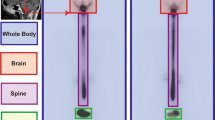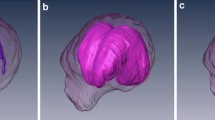Summary
A non-ionic water soluble contrast medium, 3-Deoxy-3-Iodo-d-Glucose (DIG), was experimentally evaluated for use in the cerebrospinal fluid (CSF) space, and compared with other contrast media.
Two ml (180 mgI/ml) of DIG were injected either intraventricularly or intracisternally in 15 adult mongrel dogs (average weight: 6.4 kg), and X-ray photographic, CSF, EEG, and histological studies were then performed. Additional tests were made on four beagle dogs (average weight: 9.8 kg), focussing particularly on changes in cell count and protein in the CSF following alternate intracisternal injections of 2 ml (170 mgI/ml) of DIG and metrizamide (Amipaque®), and on epileptogenicity following intracisternal injection of 3 ml (300 mgI/ml)of DIG.
That DIG provides adequate definition was demonstrated both by the ventriculograms and cisternograms, and by comparison with metrizamide. Neither epileptic discharges in the EEG nor epileptic symptoms were seen in any of the dogs used in the studies. In the CSF drawn 24 hours after the injection, protein tended to increase moderately with DIG, but pleocytosis was mild with both media. Histological studies of the central nervous system structures around the cisterna magna revealed no definite abnormal findings. Neither fibrosis nor arachnoid adhesions were seen in scanning electron microscopic observations of the basal subarachnoid spaces.
Similar content being viewed by others
References
Bergvall, U., Brismar, T., Lying-Tunell, U., Valdimarsson, E., Confusion, myoclonus and speech arrest: Epileptic manifestations after metrizamide myelography. Acta Neurol. Scand.63 (1981), 315–322.
Bertoni, J. M., Schwartzman, R. J., Horn, G. V., Partin, J., Asterixis and encephalopathy following metrizamide myelography: Investigations into possible mechanisms and review of the literature. Ann. Neurol.9 (1981), 366–370.
Gelmers, H. J., Adverse side effects of metrizamide in myelography. Neuroradiol.18 (1979), 119–123.
Gimenez, M., Martinez, F., Feijioo, M., Asterixis or myoclonus after metrizamide myelography. Arch. Neurol.38 (1981), 472.
Hindmarsh, T., Grepe, A., Widen, L., Metrizamide-phenothiazine interaction. Acta Radiol. (Diag.)16 (1975), 129–134.
Hindmarsh, T., Lumbar myelography with meglumine iocarmate and metrizamide. Acta Radiol. (Diag.)16 (1975), 209–222.
Nielsen, H., Epileptic seizures following cervical myelography. Neuroradiol.10 (1975), 59–60.
Paling, M. R., Quindlen, E. A., di Chiro, G., Spinal seizures after metrizamide myelography in a patient with spinal block. Amer. J. Roent.135 (1980), 1091–1092.
Russel, D., Anke, I. M., Nyberg-Hansen, R., Slettnes, O., Sortland, O., Veger, T., Complex partial status epilepticus following myelography with metrizamide. Ann. Neurol.8 (1980), 325–327.
Suzuki, S., Kawaguchi, S., Mita, R., Iwabuchi, T., Ventriculography with methylglucamine iocarmate (Dimer-X). Experimental and clinical study. Acta Neurochir. (Wien)33 (1976), 219–231.
Suzuki, S., Ito, K., Iwabuchi, T., Ventriculography with non-ionic watersoluble contrast medium, Amipaque (metrizamide). Comparative experimental and clinical studies. J. Neurosurg.47 (1977), 79–85.
Taguma, N., Tsubokawa, T., Sugawara, T., Tomizawa, N., Katayama, Y., Moriyasu, N., Tsuya, A., Shigematsu, A., Evaluation of 3-Deoxy-3-Iodo-d-Glucose as a contrast medium in the neurosurgical field. Jap. J. Radiol.24 (1979), 201–202.
Tsuya, A., Shigematsu, A., A study on the use of a glucose analog (3-Deoxy-3-Iodoglucose labeled with radioiodine) as an indicator of glucose metabolism in the whole body. Scientific program of XIV International Congress of Radiology. (Rio de Janeiro) p. 562, 1977.
Vincent, F. M., Asterixis after metrizamide myelography. JAMA244 (1980), 2727.
Vincent, F. M., Zimmerman, J. E., Metrizamide encephalopathy. Ann. Neurol.7 (1980), 494.
Author information
Authors and Affiliations
Rights and permissions
About this article
Cite this article
Suzuki, S., Ebina, K., Sekiya, T. et al. Non-ionic water soluble contrast medium 3-Deoxy-3-Iodo-D-Glucose (DIG) for use in the CSF space. An experimental study with mongrel and beagle dogs. Acta neurochir 70, 255–267 (1984). https://doi.org/10.1007/BF01406654
Issue Date:
DOI: https://doi.org/10.1007/BF01406654




